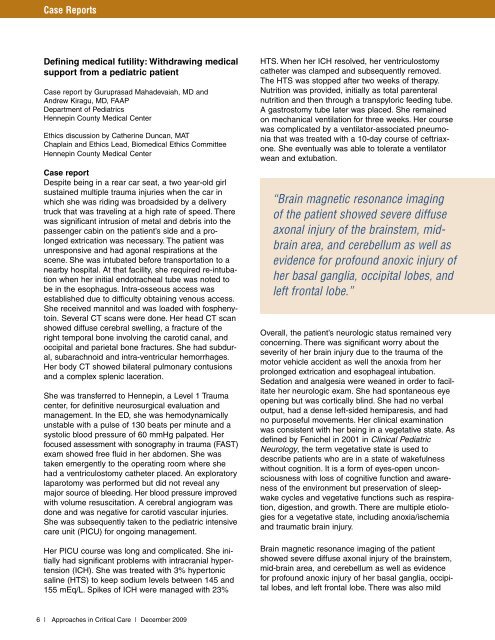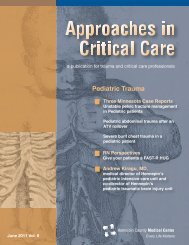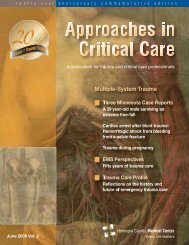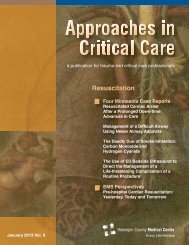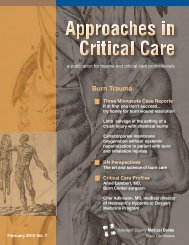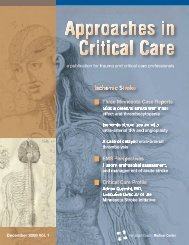Download - Hennepin County Medical Center
Download - Hennepin County Medical Center
Download - Hennepin County Medical Center
Create successful ePaper yourself
Turn your PDF publications into a flip-book with our unique Google optimized e-Paper software.
Case Reports<br />
Defining medical futility: Withdrawing medical<br />
support from a pediatric patient<br />
Case report by Guruprasad Mahadevaiah, MD and<br />
Andrew Kiragu, MD, FAAP<br />
Department of Pediatrics<br />
<strong>Hennepin</strong> <strong>County</strong> <strong>Medical</strong> <strong>Center</strong><br />
Ethics discussion by Catherine Duncan, MAT<br />
Chaplain and Ethics Lead, Biomedical Ethics Committee<br />
<strong>Hennepin</strong> <strong>County</strong> <strong>Medical</strong> <strong>Center</strong><br />
Case report<br />
Despite being in a rear car seat, a two year-old girl<br />
sustained multiple trauma injuries when the car in<br />
which she was riding was broadsided by a delivery<br />
truck that was traveling at a high rate of speed. There<br />
was significant intrusion of metal and debris into the<br />
passenger cabin on the patient’s side and a prolonged<br />
extrication was necessary. The patient was<br />
unresponsive and had agonal respirations at the<br />
scene. She was intubated before transportation to a<br />
nearby hospital. At that facility, she required re-intubation<br />
when her initial endotracheal tube was noted to<br />
be in the esophagus. Intra-osseous access was<br />
established due to difficulty obtaining venous access.<br />
She received mannitol and was loaded with fosphenytoin.<br />
Several CT scans were done. Her head CT scan<br />
showed diffuse cerebral swelling, a fracture of the<br />
right temporal bone involving the carotid canal, and<br />
occipital and parietal bone fractures. She had subdural,<br />
subarachnoid and intra-ventricular hemorrhages.<br />
Her body CT showed bilateral pulmonary contusions<br />
and a complex splenic laceration.<br />
She was transferred to <strong>Hennepin</strong>, a Level 1 Trauma<br />
center, for definitive neurosurgical evaluation and<br />
management. In the ED, she was hemodynamically<br />
unstable with a pulse of 130 beats per minute and a<br />
systolic blood pressure of 60 mmHg palpated. Her<br />
focused assessment with sonography in trauma (FAST)<br />
exam showed free fluid in her abdomen. She was<br />
taken emergently to the operating room where she<br />
had a ventriculostomy catheter placed. An exploratory<br />
laparotomy was performed but did not reveal any<br />
major source of bleeding. Her blood pressure improved<br />
with volume resuscitation. A cerebral angiogram was<br />
done and was negative for carotid vascular injuries.<br />
She was subsequently taken to the pediatric intensive<br />
care unit (PICU) for ongoing management.<br />
Her PICU course was long and complicated. She initially<br />
had significant problems with intracranial hypertension<br />
(ICH). She was treated with 3% hypertonic<br />
saline (HTS) to keep sodium levels between 145 and<br />
155 mEq/L. Spikes of ICH were managed with 23%<br />
HTS. When her ICH resolved, her ventriculostomy<br />
catheter was clamped and subsequently removed.<br />
The HTS was stopped after two weeks of therapy.<br />
Nutrition was provided, initially as total parenteral<br />
nutrition and then through a transpyloric feeding tube.<br />
A gastrostomy tube later was placed. She remained<br />
on mechanical ventilation for three weeks. Her course<br />
was complicated by a ventilator-associated pneumonia<br />
that was treated with a 10-day course of ceftriaxone.<br />
She eventually was able to tolerate a ventilator<br />
wean and extubation.<br />
“Brain magnetic resonance imaging<br />
of the patient showed severe diffuse<br />
axonal injury of the brainstem, midbrain<br />
area, and cerebellum as well as<br />
evidence for profound anoxic injury of<br />
her basal ganglia, occipital lobes, and<br />
left frontal lobe.”<br />
Overall, the patient’s neurologic status remained very<br />
concerning. There was significant worry about the<br />
severity of her brain injury due to the trauma of the<br />
motor vehicle accident as well the anoxia from her<br />
prolonged extrication and esophageal intubation.<br />
Sedation and analgesia were weaned in order to facilitate<br />
her neurologic exam. She had spontaneous eye<br />
opening but was cortically blind. She had no verbal<br />
output, had a dense left-sided hemiparesis, and had<br />
no purposeful movements. Her clinical examination<br />
was consistent with her being in a vegetative state. As<br />
defined by Fenichel in 2001 in Clinical Pediatric<br />
Neurology, the term vegetative state is used to<br />
describe patients who are in a state of wakefulness<br />
without cognition. It is a form of eyes-open unconsciousness<br />
with loss of cognitive function and awareness<br />
of the environment but preservation of sleepwake<br />
cycles and vegetative functions such as respiration,<br />
digestion, and growth. There are multiple etiologies<br />
for a vegetative state, including anoxia/ischemia<br />
and traumatic brain injury.<br />
Brain magnetic resonance imaging of the patient<br />
showed severe diffuse axonal injury of the brainstem,<br />
mid-brain area, and cerebellum as well as evidence<br />
for profound anoxic injury of her basal ganglia, occipital<br />
lobes, and left frontal lobe. There was also mild<br />
6 | Approaches in Critical Care | December 2009


